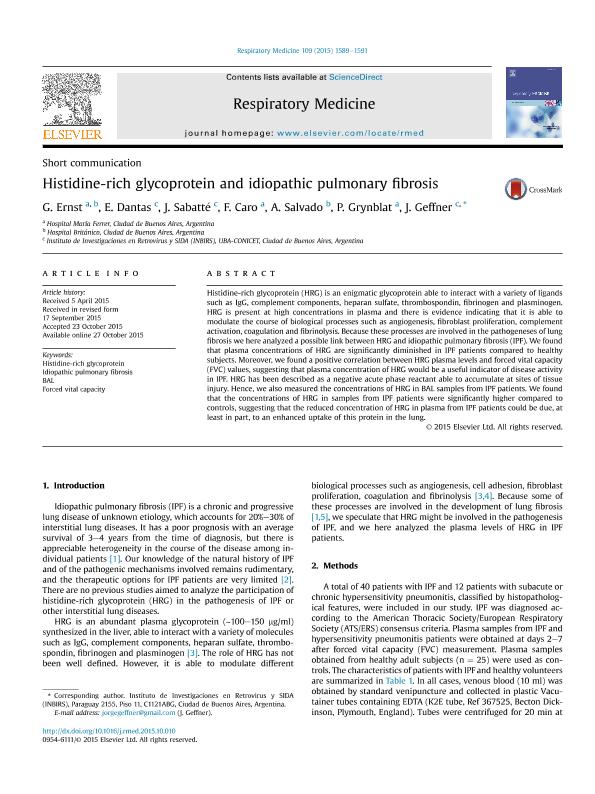Artículo
Histidine-rich glycoprotein and idiopathic pulmonary fibrosis
Ernst, G.; Dantas, Ezequiel Carlos ; Sabatte, Juan Atilio
; Sabatte, Juan Atilio ; Caro, F.; Salvado, A.; Grynblat Pipman, Luciana; Geffner, Jorge Raúl
; Caro, F.; Salvado, A.; Grynblat Pipman, Luciana; Geffner, Jorge Raúl
 ; Sabatte, Juan Atilio
; Sabatte, Juan Atilio ; Caro, F.; Salvado, A.; Grynblat Pipman, Luciana; Geffner, Jorge Raúl
; Caro, F.; Salvado, A.; Grynblat Pipman, Luciana; Geffner, Jorge Raúl
Fecha de publicación:
12/2015
Editorial:
W B Saunders Co Ltd
Revista:
Respiratory Medicine.
ISSN:
0954-6111
Idioma:
Inglés
Tipo de recurso:
Artículo publicado
Clasificación temática:
Resumen
Histidine-rich glycoprotein (HRG) is an enigmatic glycoprotein able to interact with a variety of ligands such as IgG, complement components, heparan sulfate, thrombospondin, fibrinogen and plasminogen. HRG is present at high concentrations in plasma and there is evidence indicating that it is able to modulate the course of biological processes such as angiogenesis, fibroblast proliferation, complement activation, coagulation and fibrinolysis. Because these processes are involved in the pathogeneses of lung fibrosis we here analyzed a possible link between HRG and idiopathic pulmonary fibrosis (IPF). We found that plasma concentrations of HRG are significantly diminished in IPF patients compared to healthy subjects. Moreover, we found a positive correlation between HRG plasma levels and forced vital capacity (FVC) values, suggesting that plasma concentration of HRG would be a useful indicator of disease activity in IPF. HRG has been described as a negative acute phase reactant able to accumulate at sites of tissue injury. Hence, we also measured the concentrations of HRG in BAL samples from IPF patients. We found that the concentrations of HRG in samples from IPF patients were significantly higher compared to controls, suggesting that the reduced concentration of HRG in plasma from IPF patients could be due, at least in part, to an enhanced uptake of this protein in the lung.
Archivos asociados
Licencia
Identificadores
Colecciones
Articulos(INBIRS)
Articulos de INSTITUTO DE INVESTIGACIONES BIOMEDICAS EN RETROVIRUS Y SIDA
Articulos de INSTITUTO DE INVESTIGACIONES BIOMEDICAS EN RETROVIRUS Y SIDA
Citación
Ernst, G.; Dantas, Ezequiel Carlos; Sabatte, Juan Atilio; Caro, F.; Salvado, A.; et al.; Histidine-rich glycoprotein and idiopathic pulmonary fibrosis; W B Saunders Co Ltd; Respiratory Medicine.; 109; 12; 12-2015; 1589-1591
Compartir
Altmétricas



